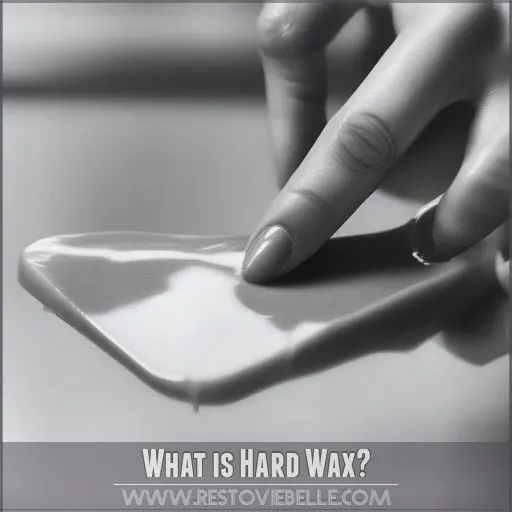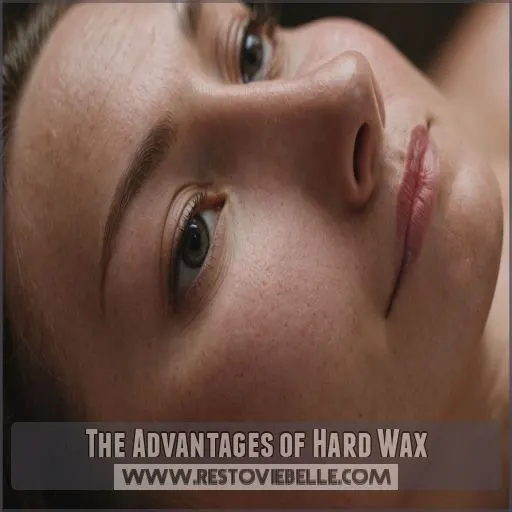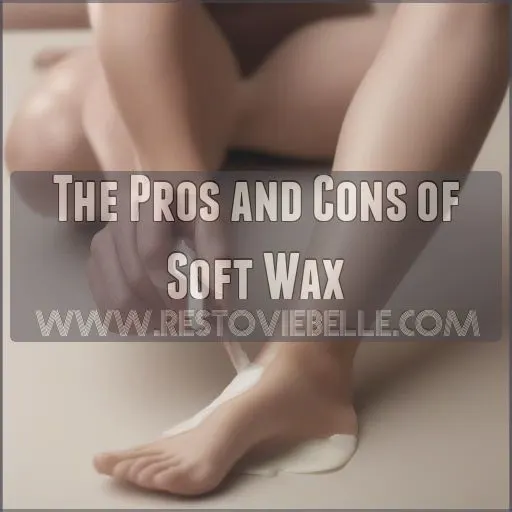This site is supported by our readers. We may earn a commission, at no cost to you, if you purchase through links.
 Now, choosing between hard wax and soft wax is like picking the perfect BBQ sauce – it all comes down to your personal taste and the task at hand.
Now, choosing between hard wax and soft wax is like picking the perfect BBQ sauce – it all comes down to your personal taste and the task at hand.
Hard wax is the James Bond of hair removal – smooth, sophisticated, and oh-so-gentle on sensitive skin. It’s a real charm for those bikini line blues or pesky underarm fuzz.
Soft wax, on the other hand, is more like your dependable old friend – great for tackling bigger areas like legs and arms.
Ultimately, the right wax comes down to your hair type, skin sensitivity, and the area you’re targeting.
Trust us, you’ll be silky-smooth in no time with the right wax, and it’s all about finding what works best for you.
Table Of Contents
- Key Takeaways
- What is Hard Wax?
- The Advantages of Hard Wax
- When is Hard Wax the Better Choice?
- What is Soft Wax?
- The Pros and Cons of Soft Wax
- Hard Wax Vs. Soft Wax: Choosing the Right Option
- Frequently Asked Questions (FAQs)
- Which is better, soft wax or hard wax?
- What are the cons of hard wax?
- Can I use soft wax for Brazilian?
- Is it better to wax your upper lip hard or soft?
- Can wax be applied over any finish?
- What qualities does wax improve or take away?
- Is there something better than wax objectively?
- How much variation is there between wax brands?
- What are the most commonly used wax types?
- Conclusion
Key Takeaways
- The right waxing solution for you depends on your hair type, skin sensitivity, and the body area you are targeting – hard wax is gentler on sensitive spots, while soft wax works better for larger areas.
- Hard wax is the James Bond of hair removal: it adheres only to the hair, not your skin, making it a super-smooth and painless experience, especially for bikini lines and underarms. Soft wax, on the other hand, is like your dependable old friend – great for tackling bigger zones like legs and arms.
- For sensitive skin types, hard wax is your new best friend. Its polymer film formula grips the hair without stripping away precious top layers of skin, so you can say goodbye to irritation and hello to silky-smooth results.
- Whether you choose hard wax or soft wax, remember to always prioritize your safety and comfort. Consult a licensed professional, avoid waxing irritated skin, and treat any skin tears promptly for the best experience.
What is Hard Wax?
Hard wax might just be the secret to a painless hair removal experience.
With its ability to harden on the skin without sticking to it, hard wax offers a gentler alternative to traditional soft wax methods.
Hard Wax Properties and Formulas
Hard wax is a versatile hair removal solution, crafted with a polymer film that adheres to the hair, not your skin.
These non-polymer blends offer a gentler experience, making hard wax an ideal choice for sensitive areas like the bikini line.
Application and Removal Process
To apply hard wax, scoop a generous dollop and spread it on the skin with a waxing spatula, working in the direction of hair growth.
Allow it to fully solidify, then grasp the edge and swiftly pull against the grain.
This shrink-wrap technique avoids stripping away precious top layers of skin.
The Main Benefits of Hard Wax
The beauty of hard wax lies in its gentle touch and efficient removal.
Wrapping hair like a shrink-fit, it lifts strands without clinging to delicate skin, making it a dream for sensitive areas.
Bid farewell to pesky residue and enjoy a virtually painless experience – the gift that keeps on giving.
The Advantages of Hard Wax
Hard wax is definitely the superior choice for hassle-free hair removal.
It offers a pain-free experience with its gentle touch and lack of messy strips.
This leaves your skin feeling soft and smooth.
Gentler on Sensitive Skin
If you have sensitive skin, hard wax is a gentler option compared to soft wax. The formula adheres only to the hair, not your skin, making it less irritating.
Plus, the lack of waxing strips means you’ll experience less pulling and tugging – a major advantage for tricky areas like the bikini line. Hard wax is an excellent choice for targeting these areas.
No Strips Needed
With hard wax, you don’t need those pesky waxing strips – the wax itself hardens and grabs the hair, allowing you to remove it easily without any additional tools. [1,3]
This stripless application means less mess, less irritation, and a smoother, more controlled waxing experience overall.
Say goodbye to ripped skin and hello to a relaxing, hassle-free hair removal routine.
Less Painful Experience
For sensitive skin, hard wax is a good choice.
Unlike soft wax, this thicker formula adheres solely to the hair, rather than your delicate epidermis.
This gentle approach results in a less painful waxing experience, perfect for those with lower pain tolerances or areas prone to irritation.
Less Residue Left Behind
After your waxing session, you’ll be delighted to find that hard wax leaves behind far less residue than its soft counterpart.
Simply sweep away any stray bits with a light oil or wipe, and you’ll be left with silky-smooth, clean skin.
This makes hard wax the ideal choice for those seeking a tidy, fuss-free hair removal experience.
When is Hard Wax the Better Choice?
When is hard wax the better choice?
If you’re targeting smaller, delicate areas like the bikini line or underarms, hard wax is typically the gentler, less painful option.
And for those with sensitive skin, hard wax’s ability to adhere to hair instead of skin makes it a preferred choice.
Ideal for Smaller Areas
Why is hard wax ideal for smaller areas?
With its targeted grip, hard wax effortlessly tackles bikini lines, underarms, and even facial hair without irritating sensitive skin.
Simply apply, let it harden, then remove for a smoother, longer-lasting finish compared to soft wax alternatives.
Suitable for Delicate Regions
Hard wax is ideal for tackling delicate regions like the bikini line or underarms.
Its gentle formula won’t irritate sensitive skin, making it a go-to choice for facial waxing.
The hypoallergenic synthetic resin and skin-soothing ingredients help to create a smooth, fuss-free experience, minimizing the risk of ingrown hairs.
Preferred by Those With Sensitive Skin
If you have sensitive skin, hard wax is the better choice for targeted areas like the face or bikini zone. This type of wax is gentler, minimizing irritation and the risk of ingrown hairs.
With no need for strips, the process is less painful and leaves behind less residue.
Hard wax’s superior adherence to hair over skin makes it a skin-soothing winner for those with delicate complexions.
What is Soft Wax?
While hard wax may be the star of the show, soft wax has its own set of unique benefits.
Soft wax adheres to both hair and skin, making it a great option for larger body areas like legs and arms.
Soft Wax Properties and Formulas
Soft wax is the more traditional option for hair removal.
Unlike its counterpart, soft wax adheres to both the hair and the skin, requiring the use of waxing strips for removal.
Soft wax formulas tend to be more pliable and spreadable, making them ideal for larger areas like the legs or back.
These waxes typically have a lower melting point, allowing for a quicker application process.
While soft wax may be slightly more messy, it can be an economical choice for those seeking an efficient hair removal solution.
The Main Benefits of Soft Wax
As a versatile hair removal solution, soft wax offers several notable benefits.
First, its formulation allows for faster application, making it ideal for larger areas like the legs and back.
Additionally, soft wax can be a more affordable option compared to hard wax. Unlike its harder counterpart, soft wax is less likely to break during application, providing a smoother experience.
In addition, soft wax can be applied at lower temperatures, potentially reducing discomfort for those with sensitive skin.
Whether you’re a seasoned waxer or new to the process, understanding the advantages of soft wax can help you choose the right solution for your unique needs.
The Pros and Cons of Soft Wax
While hard wax may be the gentler, more preferred option, soft wax has its advantages.
Soft wax can be faster to apply on larger areas and potentially more affordable.
Though it does carry a higher risk of irritation and requires the use of waxing strips.
Faster Application for Large Areas
One advantage of soft wax is that it can be applied faster to larger areas .
Its flexible formula allows you to spread it thinly and cover more ground in less time compared to hard wax.
For clients looking to get their legs or back waxed efficiently, soft wax may be the ideal choice.
Potentially More Affordable
Your budget may find soft wax to be the more affordable option, often costing between $5 – $15 per pack versus the higher price tag of hard wax.
Plus, soft wax requires less specialized equipment, making it a more accessible choice for at-home or salon use.
Just be mindful of the potential for greater skin irritation.
Higher Risk of Irritation
Soft wax‘s propensity for irritation is one of its key drawbacks. With higher risk of skin redness, ingrown hairs, and unpleasant sensations, it may not be the ideal choice for those with sensitive skin.
A handy table can help illustrate the potential pros and cons:
| Pros | Cons |
|---|---|
| Faster application | Higher irritation risk |
| More affordable | Potential for ingrown hairs |
| Removes hair efficiently | Requires waxing strips |
While soft wax has its benefits, the increased likelihood of irritation is an important factor to weigh when selecting the right waxing solution [1,3].
Requires Waxing Strips
When working with soft wax, plan to use waxing strips to remove the wax and hair.
While these strips can make the process less painful than hard wax, they may leave some skin irritation behind.
Luckily, you have options to manage this, like:
- Applying soothing lotions after the service
- Advising clients to avoid retrying stubborn areas
- Considering hard wax for more sensitive regions
Hard Wax Vs. Soft Wax: Choosing the Right Option
Trying to decide between hard wax and soft wax for your next hair removal session?
Understanding the strengths of each can help you pick the perfect solution that fits your skin type and needs.
Let’s explore the key factors to keep in mind when choosing between these two wax options, including the key factors to consider.
Factors to Consider for Hair Removal
Waxing effectiveness depends on your hair type and skin’s sensitivity.
Consider if your strands are coarse or fine, and if you have delicate areas needing gentle treatment.
A hard wax may be better for short, stubborn hairs, while soft wax suits larger regions.
| Factor | Hard Wax | Soft Wax |
|---|---|---|
| Hair Type | Coarse | Fine |
| Skin Sensitivity | Sensitive | Tougher |
| Body Area | Delicate, Sensitive | Larger, Less Sensitive |
| Application | Thicker, Twice on Same Spot | Thinner Layers |
Understanding Client Needs and Skin Types
Your clients’ unique skin types and hair growth patterns are important in selecting the right wax.
While soft wax excels on larger areas [1,2], hard wax is gentler on sensitive spots like the bikini line [1,2,3].
Discuss their needs, preferences, and past experiences to provide the ideal waxing solution that’s perfect just for them, including their unique needs [1,2,4].
Importance of Waxing Safety and Precautions
Ensuring proper waxing safety is important to avoiding injury or infection.
Follow a few simple precautions: Avoid waxing irritated skin, Always use a licensed technician, Treat any skin tears promptly, and Refrain from certain activities post-wax.
With these steps, you can enjoy smooth, confident results.
Frequently Asked Questions (FAQs)
Which is better, soft wax or hard wax?
Finding the right waxing approach is like a dance – you’ve gotta choose your partner wisely.
Soft wax is great for large areas.
While hard wax is a true smoothie for sensitive spots.
What are the cons of hard wax?
One major con of using hard wax is that it’s more expensive for larger areas like legs or back compared to soft wax.
Hard wax is best suited for smaller, sensitive spots like the face or bikini line. (Source)
Can I use soft wax for Brazilian?
You can certainly use soft wax for a Brazilian, though many experts recommend hard wax as the better option.
Soft wax can provide fast results, but hard wax allows for reapplication on stubborn areas.
Is it better to wax your upper lip hard or soft?
Like a skilled hairstylist, for tackling those pesky upper lip hairs, hard wax is the salon-savvy solution – a gentler waxing dance that leaves your skin smooth and happy.
Can wax be applied over any finish?
Wax can be applied over a variety of existing finishes, though the results may vary.
Always do a spot test first to make sure it’s compatible and achieve your desired look.
What qualities does wax improve or take away?
Waxing your wood adds a lovely natural sheen, but it won’t protect against heavy wear and tear like polyurethane.
Wax is best for low-traffic surfaces that require a softer, more organic look (Source).
However, it requires more frequent reapplication.
Is there something better than wax objectively?
Sugaring is an all-natural alternative that’s gentler on your skin compared to waxing.
It minimizes irritation, reduces ingrown hairs, and leaves you feeling silky smooth.
Give it a try – your skin will thank you! (Source)
How much variation is there between wax brands?
With so many wax brands on the market, knowing which one delivers the best results can feel like a guessing game.
But the pros have spoken – Mermaid Wax Signature Series is the #1 choice for its unbeatable elastic, hypoallergenic, and vegan formula.
What are the most commonly used wax types?
Sounds like you’re keen to get the lowdown on wax – the secret to silky-smooth skin, if you ask me!
Well, the most popular types are soft wax, hard wax, and pre-made wax strips – each with its own pros and perks.
Conclusion
Ultimately, narrowing down the perfect hair removal wax is akin to finding your soulmate – it takes some trial and error, but the right fit will have you feeling silky-smooth and confident.
Whether you opt for the suave sophistication of hard wax or the trusty dependability of soft wax, the key is understanding your hair type, skin sensitivity, and the area being treated.
With the right hard wax vs. soft wax approach, you’ll be on your way to a flawless, fuzz-free finish.












